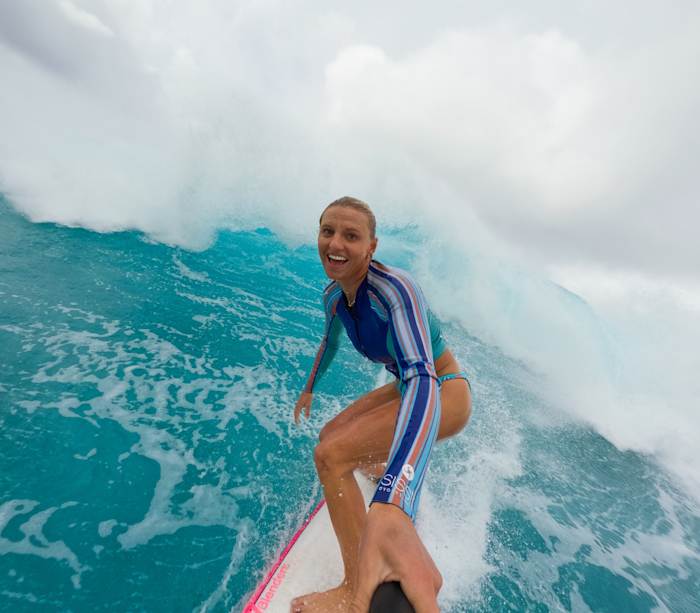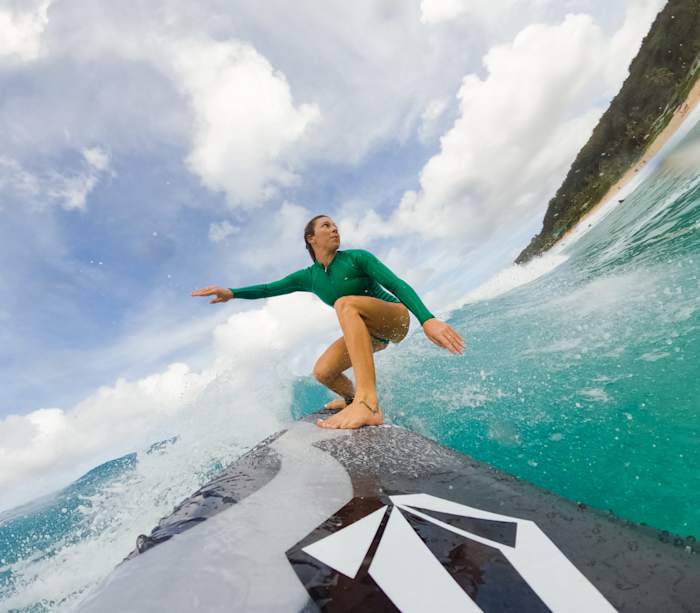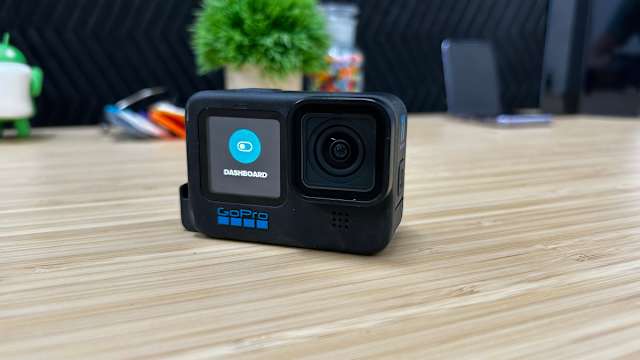
What Do an Olympic Snowboarder and Two Professional Surfers Have in Common? They All Use a GoPro
Sports Illustrated aims to feature only the best products and services. If you buy something via one of our links, we may earn a commission.
I just got back from the 2023 GoPro Creator Summit, which took place in Fiji. Also in attendance were 50 creators and athletes from 21 different countries, with the lone goal of capturing as much amazing content as possible using GoPro’s Hero12 Black action camera.
To ensure there was no shortage of opportunities to film, GoPro took attendees on helicopter rides, skydiving, free diving, snorkeling, jet skiing and in speed boats that raced down the Sigatoka River. Oh, of course, supplied us all with the Hero12 Black ($349, was $400 at Amazon) action camera.
Throughout the week, I watched and listened to many of the attendees talk about their approach to recording and creating content on their GoPro, and then, as the week came to an end, I was able to sit down and talk with three amazing athletes, all of whom have used GoPro cameras to capture their latest adventure. We chatted about how they got started with GoPro, their favorite accessories and mounts, along with how they edit their content.
Professional Surfer: Lakey Peterson
Lakey Peterson is a professional surfer who uses the GoPro Hero12 Black to capture herself surfing globally. Peterson started using a GoPro about nine years ago, not long after GoPro CEO Nick Woodman created the action camera to capture himself surfing.
Kelly Slater, another professional surfer, started using a GoPro to record himself, stoking Peterson’s interest in using one even more. Peterson eventually met with the GoPro team in Hawaii and has been using a GoPro to capture and create content of herself surfing ever since.
Lakey’s must-have GoPro accessories: Peterson uses a combination of accessories and mounts to get all of her shots. A staple of her setup is the Handler, which is a small hand grip with a wrist strap that floats in the water when you inevitably drop it.
GoPro’s Bite Mount allows Peterson to capture point-of-view shots from her GoPro. Admittedly, I was skeptical of the Bite Mount, but after seeing several videos captured from what more or less equates to your point of view, the mount just makes sense.
Peterson uses both mounts simultaneously, telling me that she’ll “put a bite mount on the Handler as well, so I can have it in my mouth if I want or have it in my hand and be able to change up the angles.” It looks weird when it’s all put together, but it makes total sense when you see someone using it that way.
Finally, Peterson uses the Surfboard Camera Mounts, which stick to the nose of the surfboard, allowing you to point the camera either to capture what’s in front of you or back to get a shot of yourself riding the waves.
Lakey’s favorite type of shot: With various mounting options and years of experience, I wanted to know what Peterson’s favorite type of mount or shot was: “My favorite shot is usually when I have the GoPro on the very nose of my surfboard, and it’s looking back, it gives a very unique perspective that with GoPro no one else could capture.”
Going beyond capturing herself surfing, Peterson has recently started vlogging with a GoPro: “I want to have all these memories [of the stuff] I get to do all the time.” Her vlogs can be found on her YouTube channel.
As for editing her videos and pictures, Peterson uses GoPro’s Quik app on her smartphone to transfer, save and edit photos before sharing them across her social accounts. She gives her husband all of the credit when editing videos, since he edits everything for her, usually in Apple’s Final Cut Pro.
The Essentials:
- GoPro Hero12 Black, $350 (was $400) at Amazon or GoPro
- Handler, $30 at Amazon or GoPro
- Bite Mount, $20 at Amazon or GoPro
- Surfboard Mount, $20 at Amazon or GoPro
Olympic Snowboarder: Elena Hight
Elena Hight is a professional snowboarder who competed in halfpipe for 16 years, including in the 2006 and 2010 Winter Olympics but has shifted her focus to big mountain and free riding. That includes split boarding, which requires you to hike up a mountain before riding down it. But instead of packing a dedicated pair of snowshoes, your snowboard splits into two pieces that you wear as snowshoes, and then you put the board back together and ride down.
Hight has been using a GoPro to capture herself riding for the last 11 years with the GoPro Hero2, starting back when she was competing in half pipe. Since then, she’s “been able to adapt and use the camera in so many different scenarios in snowboarding.” She said, “In this new avenue of my career, a GoPro is one of the most important tools that I have to be able to capture what I’m doing.”
Elena’s must-have GoPro accessories: The most common mount Hight uses is some sort of head mount, be it the Helmet mount, a Vented Helmet Strap Mount, a head strap, or even the Curved + Flat Adhesive Mounts; whatever it takes to attach a GoPro to her helmet.
Of course, the Bite Mount is also often used to get those amazing point-of-view shots sans a helmet.
While hiking up the mountains, Hight also uses a selfie stick like the El Grande, attaching it to her poles as she hikes.
Elena’s favorite type of shot: Hight didn’t call out a specific shot when I asked about her favorite. Instead, we talked a lot about the versatility of the GoPro and all of the mounts. Without a GoPro, according to Hight, “there is no way to have that up close and personal look of big mountain, riding, unless you’re filming it yourself.” The combination of GoPro’s up close, and personal perspective paired with long lens cameras have “changed the way snowboard films are made”
Hight also often works with drone pilots who use a combination of GoPro cameras on FPV or DJI drones, depending on the situation.
When it comes to editing, Hight admits that editing isn’t her “strong suit” and that she’s relied a lot on the GoPro Quik app for viewing, transferring and editing her footage.
The Essentials:
- GoPro Hero12 Black, $350 (was $400) at Amazon or GoPro
- Helmet Front + Side Mount, $24 at Amazon or GoPro
- Vented Helmet Strap Mount, $15 at Amazon or GoPro
- Head Strap 2.0, $25 at Amazon or GoPro
- Curved + Flat Adhesive Mounts, $20 at Amazon or GoPro
- Bite Mount, $20 at Amazon or GoPro
- El Grande, $47 (was $60) at Amazon or GoPro
Professional Surfer: Coco Ho
Coco Ho is a professional surfer from Hawaii who has been surfing for over 20 years. She’s been using a GoPro since the Hero5 or Hero6 when she would follow her brother (and vice versa) with a GoPro while surfing. She’s been working with GoPro for about the last seven years, soaking up any advice and education she can from others along the way.
Coco’s must-have GoPro accessories: Coco first started using the GoPro as a follow cam with her brother, and the Bite Mount was the main accessory. Ho often uses accessories like the Handler, and like Peterson, she often attaches the Bite Mount to the Handler for added versatility now.
“The Handler floats, which is so cool. So you don’t need to have a Floaty as well.” For those unfamiliar, the Floaty is another GoPro accessory you put around the camera to ensure it floats if it comes off a mount or you drop it into the water.
When Ho isn’t traveling, she has a few boards with different mount setups, taking advantage of the Surfboard Camera Mounts to come up with unique angles and points of view for the GoPro.
Coco’s favorite type of shot: The images she’s “really proud of” are when she uses a mount that comes out from under the board or on the nose of the board “because you get the whole deal and it’s usually really nice in the barrel.”
When editing her GoPro videos and photos, Ho uses Apple’s iMovie app on her MacBook when home and the GoPro Quik app while traveling to post an Instagram Story quickly.
The Essentials:
- GoPro Hero12 Black, $350 (was $400) at Amazon or GoPro
- Bite Mount, $20 at Amazon or GoPro
- Handler, $30 at Amazon or GoPro
- Surfboard Mount, $20 at Amazon or GoPro
- Floaty for Hero12, Hero11, Hero10, and Hero9, $30 at Amazon or GoPro




